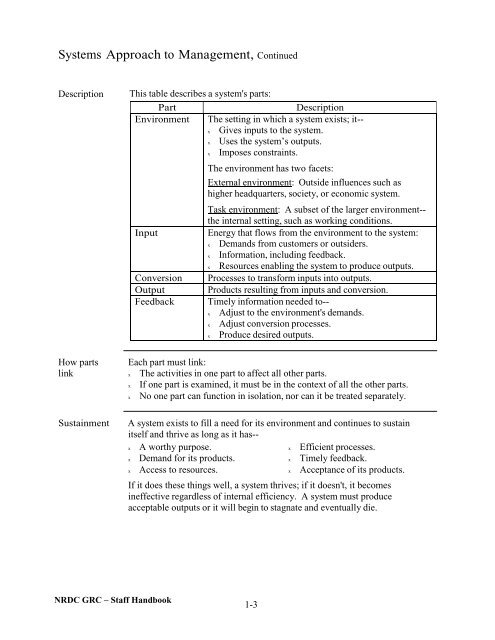GUIDELINES TO NRDC feb 24 2014
GUIDELINES TO NRDC feb 24 2014 GUIDELINES TO NRDC feb 24 2014
Systems Approach to Management, ContinuedDescriptionHow partslinkSustainmentThis table describes a system's parts:PartDescriptionEnvironment The setting in which a system exists; it--x Gives inputs to the system.x Uses the system’s outputs.x Imposes constraints.InputConversionOutputFeedbackThe environment has two facets:External environment: Outside influences such ashigher headquarters, society, or economic system.Task environment: A subset of the larger environment--the internal setting, such as working conditions.Energy that flows from the environment to the system:x Demands from customers or outsiders.x Information, including feedback.x Resources enabling the system to produce outputs.Processes to transform inputs into outputs.Products resulting from inputs and conversion.Timely information needed to--x Adjust to the environment's demands.x Adjust conversion processes.x Produce desired outputs.Each part must link:x The activities in one part to affect all other parts.x If one part is examined, it must be in the context of all the other parts.x No one part can function in isolation, nor can it be treated separately.A system exists to fill a need for its environment and continues to sustainitself and thrive as long as it has--x A worthy purpose.x Efficient processes.x Demand for its products.x Timely feedback.x Access to resources.x Acceptance of its products.If it does these things well, a system thrives; if it doesn't, it becomesineffective regardless of internal efficiency. A system must produceacceptable outputs or it will begin to stagnate and eventually die.NRDC GRC – Staff Handbook1-3
Systems Approach to Management, ContinuedExampleFor decades American auto manufacturers made cars without fullyconsidering pressures from their environment. They ignored foreigncompetition and impact of the energy crisis. They marketed cars withoutreally knowing what customers wanted, nor did they attempt to find out.Customers reacted by turning to the better quality and designs of foreignmadecars.Finally American auto makers woke up; they examined their environment,studied the competition, and listened to their customers. They began to makequality cars that withstood competition and lured customers back into theirshowrooms.AdditionalprinciplesHere are more principles from General Systems Theory and other schools ofmanagement thought that apply to system processes:PrincipleSynergyFlexibilityContingencyEfficiencyEffectivenessDescriptioThe whole is greater than the n sum of its parts.Example: People working as a team achieve morethan they do working separately.Since there's usually more than one way to do somethingwell, we need not waste effort seeking the one best way.The situation determines what works best. Somethingthat works in one situation may fail in another becauseof time, place, or circumstance.Note: This principle has an exception. It doesn'tapply to decisions having ethical implications. Werewe to apply it to ethical decisions, it could threatenethical values for the sake of practicality.Doing things right--x The first time.x With minimum errors and waste.Doing the right things requires focusing on key goals andpriorities to accomplish the mission.Note. Efficiency and effectiveness are interdependent.However, effectiveness is more important as it is uselessto do things right if they're not the right things. Section3 discusses this notion in more detail.NRDC GRC – Staff Handbook1-4
- Page 2 and 3: PREFACEDisclaimer: The NRDC-GREECE
- Page 4 and 5: GUIDELINES TO CONSIDERBecome fully
- Page 6: Remember the mission. Avoid tunnel
- Page 9 and 10: Overview ContinuedFocusThe text foc
- Page 11 and 12: InstructionsIntroduction This secti
- Page 13 and 14: NotesNRDC GRC - Staff Handbookvi
- Page 15 and 16: Detailed Table of Contents, Continu
- Page 17: Detailed Table of Contents, Continu
- Page 20 and 21: Chapter 1Organizations and Managers
- Page 25 and 26: SubsystemsIntroduction This section
- Page 27 and 28: The Five Functions of ManagementInt
- Page 29 and 30: Types of ManagersIntroductionThis s
- Page 31 and 32: Staff Officer RolesIntroduction Peo
- Page 33 and 34: Managing and LeadingIntroduction St
- Page 36 and 37: Managing Things and Leading PeopleI
- Page 38 and 39: Delegation of Authority, ContinuedI
- Page 40 and 41: Managing Your BossIntroduction Do y
- Page 42 and 43: Chapter Summary, ContinuedKey point
- Page 44 and 45: The Staff Officer’s WorldIntroduc
- Page 46 and 47: AnticipationIntroduction Ability to
- Page 48 and 49: InitiativeIntroduction A sharp staf
- Page 50 and 51: Initiative, ContinuedKeepingactions
- Page 52 and 53: Guidance, ContinuedWhen to seekguid
- Page 54 and 55: Perspective, ContinuedPride,passion
- Page 56 and 57: Written Sources of InformationIntro
- Page 58 and 59: Providing Information and Building
- Page 60 and 61: Completed Staff Work, ContinuedPrep
- Page 62 and 63: Staff Doctrine, ContinuedBackground
- Page 64 and 65: Chapter Summary, ContinuedKey Point
- Page 66 and 67: Efficiency and EffectivenessIntrodu
- Page 68 and 69: Efficiency and Effectiveness, Conti
- Page 70 and 71: Step 1: Record Use of TimeIntroduct
Systems Approach to Management, ContinuedDescriptionHow partslinkSustainmentThis table describes a system's parts:PartDescriptionEnvironment The setting in which a system exists; it--x Gives inputs to the system.x Uses the system’s outputs.x Imposes constraints.InputConversionOutputFeedbackThe environment has two facets:External environment: Outside influences such ashigher headquarters, society, or economic system.Task environment: A subset of the larger environment--the internal setting, such as working conditions.Energy that flows from the environment to the system:x Demands from customers or outsiders.x Information, including feedback.x Resources enabling the system to produce outputs.Processes to transform inputs into outputs.Products resulting from inputs and conversion.Timely information needed to--x Adjust to the environment's demands.x Adjust conversion processes.x Produce desired outputs.Each part must link:x The activities in one part to affect all other parts.x If one part is examined, it must be in the context of all the other parts.x No one part can function in isolation, nor can it be treated separately.A system exists to fill a need for its environment and continues to sustainitself and thrive as long as it has--x A worthy purpose.x Efficient processes.x Demand for its products.x Timely feedback.x Access to resources.x Acceptance of its products.If it does these things well, a system thrives; if it doesn't, it becomesineffective regardless of internal efficiency. A system must produceacceptable outputs or it will begin to stagnate and eventually die.<strong>NRDC</strong> GRC – Staff Handbook1-3



